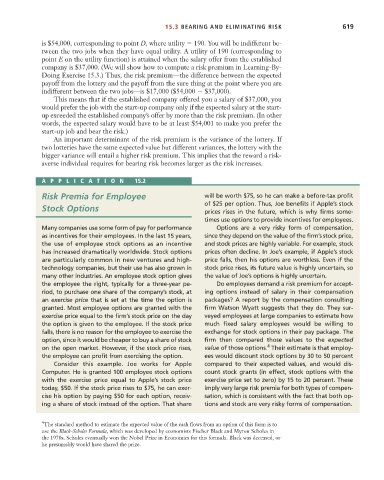Page 645 - Microeconomics, Fourth Edition
P. 645
c15riskandinformation.qxd 8/16/10 11:10 AM Page 619
15.3 BEARING AND ELIMINATING RISK 619
is $54,000, corresponding to point D, where utility 190. You will be indifferent be-
tween the two jobs when they have equal utility. A utility of 190 (corresponding to
point E on the utility function) is attained when the salary offer from the established
company is $37,000. (We will show how to compute a risk premium in Learning-By-
Doing Exercise 15.3.) Thus, the risk premium—the difference between the expected
payoff from the lottery and the payoff from the sure thing at the point where you are
indifferent between the two jobs—is $17,000 ($54,000 $37,000).
This means that if the established company offered you a salary of $37,000, you
would prefer the job with the start-up company only if the expected salary at the start-
up exceeded the established company’s offer by more than the risk premium. (In other
words, the expected salary would have to be at least $54,001 to make you prefer the
start-up job and bear the risk.)
An important determinant of the risk premium is the variance of the lottery. If
two lotteries have the same expected value but different variances, the lottery with the
bigger variance will entail a higher risk premium. This implies that the reward a risk-
averse individual requires for bearing risk becomes larger as the risk increases.
APPLICA TION 15.2
Risk Premia for Employee will be worth $75, so he can make a before-tax profit
of $25 per option. Thus, Joe benefits if Apple’s stock
Stock Options
prices rises in the future, which is why firms some-
times use options to provide incentives for employees.
Many companies use some form of pay for performance Options are a very risky form of compensation,
as incentives for their employees. In the last 15 years, since they depend on the value of the firm’s stock price,
the use of employee stock options as an incentive and stock prices are highly variable. For example, stock
has increased dramatically worldwide. Stock options prices often decline. In Joe’s example, if Apple’s stock
are particularly common in new ventures and high- price falls, then his options are worthless. Even if the
technology companies, but their use has also grown in stock price rises, its future value is highly uncertain, so
many other industries. An employee stock option gives the value of Joe’s options is highly uncertain.
the employee the right, typically for a three-year pe- Do employees demand a risk premium for accept-
riod, to purchase one share of the company’s stock, at ing options instead of salary in their compensation
an exercise price that is set at the time the option is packages? A report by the compensation consulting
granted. Most employee options are granted with the firm Watson Wyatt suggests that they do. They sur-
exercise price equal to the firm’s stock price on the day veyed employees at large companies to estimate how
the option is given to the employee. If the stock price much fixed salary employees would be willing to
falls, there is no reason for the employee to exercise the exchange for stock options in their pay package. The
option, since it would be cheaper to buy a share of stock firm then compared those values to the expected
4
on the open market. However, if the stock price rises, value of those options. Their estimate is that employ-
the employee can profit from exercising the option. ees would discount stock options by 30 to 50 percent
Consider this example. Joe works for Apple compared to their expected values, and would dis-
Computer. He is granted 100 employee stock options count stock grants (in effect, stock options with the
with the exercise price equal to Apple’s stock price exercise price set to zero) by 15 to 20 percent. These
today, $50. If the stock price rises to $75, he can exer- imply very large risk premia for both types of compen-
cise his option by paying $50 for each option, receiv- sation, which is consistent with the fact that both op-
ing a share of stock instead of the option. That share tions and stock are very risky forms of compensation.
4 The standard method to estimate the expected value of the cash flows from an option of this form is to
use the Black-Scholes Formula, which was developed by economists Fischer Black and Myron Scholes in
the 1970s. Scholes eventually won the Nobel Prize in Economics for this formula. Black was deceased, or
he presumably would have shared the prize.

